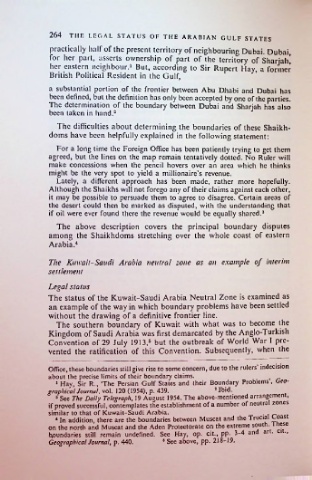Page 328 - The Arabian Gulf States_Neat
P. 328
264 THE LEGAL STATUS OF THE ARABIAN GULF STATES
practically half of the present territory of neighbouring Dubai. Dubai,
for her part, asserts ownership of part of the territory of Sharjah!
her eastern neighbour.1 But, according to Sir Rupert Hay, a former
British Political Resident in the Gulf,
a substantial portion of the frontier between Abu Dhabi and Dubai has
been defined, but the definition has only been accepted by one of the parties.
The determination of the boundary between Dubai and Sharjah has also
been taken in hand.2
The difficulties about determining the boundaries of these Shaikh-
doms have been helpfully explained in the following statement:
For a long time the Foreign Office has been patiently trying to get them
agreed, but the lines on the map remain tentatively dotted. No Ruler will
make concessions when the pencil hovers over an area which he thinks
might be the very spot to yield a millionaire's revenue.
Lately, a different approach has been made, rather more hopefully.
Although the Shaikhs will not forego any of their claims against each other,
it may be possible to persuade them to agree to disagree. Certain areas of
the desert could then be marked as disputed, with the understanding that
if oil were ever found there the revenue would be equally shared.3
The above description covers the principal boundary disputes
among the Shaikhdoms stretching over the whole coast of eastern
Arabia.4
The Kuwait-Saudi Arabia neutral zone as an example of interim
settlement
Legal status
The status of the Kuwait-Saudi Arabia Neutral Zone is examined as
an example of the way in which boundary problems have been settled
without the drawing of a definitive frontier line.
The southern boundary of Kuwait with what was to become the
Kingdom of Saudi Arabia was first demarcated by the Anglo-Turkish
Convention of 29 July 1913,5 but the outbreak of World War I pre
vented the ratification of this Convention. Subsequently, when the
Office, these boundaries still give rise to some concern, due to the rulers’ indecision
about the precise limits of their boundary claims. ,
1 Hay, Sir R., ‘The Persian Gulf States and their Boundary Problems , Geo
graphical Journal, vol. 120 (1954), p. 439. 2 Ibid.
3 See The Daily Telegraph, 19 August 1954. The above-mentioned arrangement,
if proved successful, contemplates the establishment of a number of neutral zones
similar to that of Kuwait-Saudi Arabia. . _
4 In addition, there are the boundaries between Muscat and the Trucia
on the north and Muscat and the Aden Protectorate on the extreme south. 1 hese
boundaries still remain undefined. See Hay, op. cit., pp. 3-4 and art. cit.,
Geographical Journal, p. 440. 6 See above, pp. 218-19.

